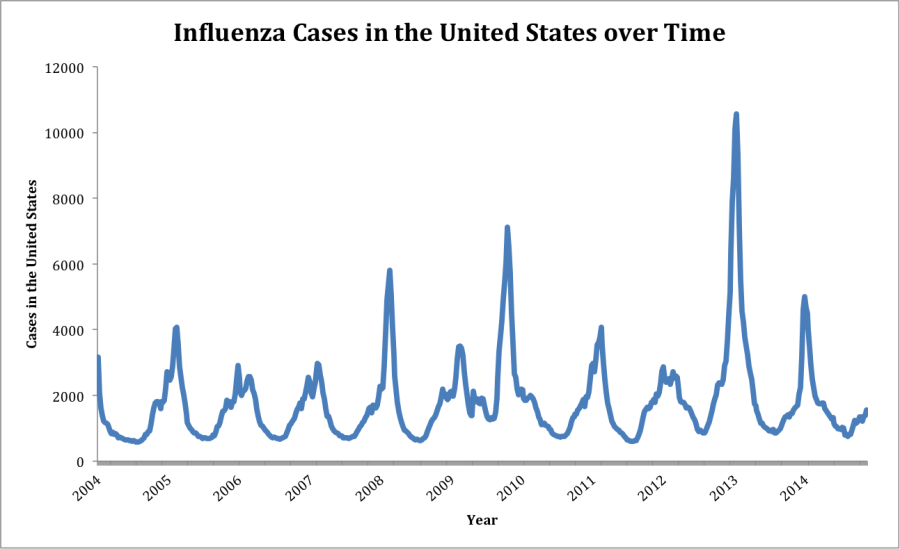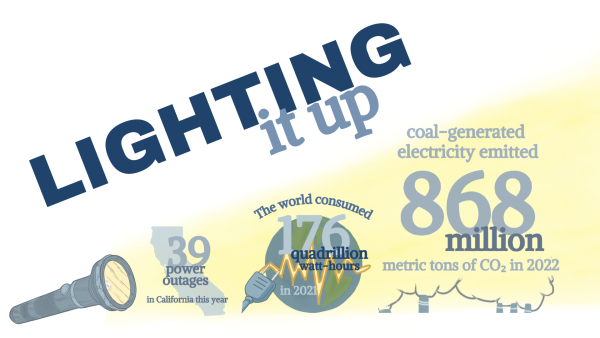Google flu trends
“I had runny nose, sore throat for sure, a little coughing, of course there was a fever,” Karan Walia (10) said.
A human doctor might associate this with influenza, but could Google?
Google has created a program to predict influenza cases called Google Flu, which collects data of user searches during the flu season and uses the frequency of certain search terms to approximate the number of influenza cases.
Google Flu works by using both past and current data. Through checking the prevalence of certain search terms and comparing them to the CDC’s records of influenza infections, Google can supposedly identify these certain undisclosed search terms as indicators of flu activity.
These terms can then be tracked immediately by Google to create a rough estimate of flu cases before the CDC conducts a formal survey. Results are regionalized by state and country, allowing specific regions to receive more specific and helpful estimates.
Google claims that their data is congruent to the CDC’s reports.
According to the Centers for Disease Control and Prevention (CDC), most flu infections occur during the winter, although cases can appear as early as October and as late as May.
Sravya Cherukuri (10) fends off flu-like symptoms nearly every year, often google searching her symptoms and turning to websites such as WebMD for a diagnosis.
“So when I [have] a flu, early in the morning I [wake] up with a sore throat. I usually go through three phases of a sore throat then it goes into congestion and [finally a] cough,” Sravya said.
Chetana Kalidindi (10) echoes a similar sentiment.
“When I am infected with the flu, my temperature rises and my head begins to pulse,” she said. “I google [my symptoms] to ensure that I do indeed have to flu and not another illness for which I would be taking the wrong medication.”
So far, Google Flu’s predictions have been widely attacked in the media due to far-fetched and overshot estimates.
According a study referenced by The New York Times, four scientists found that “Google’s flu-tracking service not only wildly overestimated the number of flu cases in the United States in the 2012-13 flu season […] but has also consistently overshot in the last few years. Google Flu Trends’ estimate for the 2011-2012 flu season was more than 50 percent higher than the cases reported by the Centers for Disease Control and Prevention.”
Google has since reprogrammed its algorithm, but even so, it notes on the Flu Trends website that “past performance is no guarantee of future results”.
Some students have voiced skepticism regarding the accuracy of Google’s predictions.
“I think it’s a bit of stretch,” Rishab Gargeya (10) said. “Considering the amount of people who use Google, they could get some pretty good sample data from that, but I don’t think it’s anything prominent enough to get a good conclusion from.
Influenza can be prevented simply by getting a vaccination. “I’ve never had influenza [because] I take my flu shots,” Rishabh Chandra (11) said.
As of November 17th, Google Flu estimates the flu activity for California to be “low,” and experimental data
Although Google Flu has had a rough debut, the technology used in it could be refined to potentially prevent thousands of influenza-related deaths, it could be expanded upon to encompass other diseases. Google has already applied the technology to dengue.
This piece was originally published in the pages of the Winged Post on November 21, 2014.
Derek Yen is a senior and the Opinion Editor of Winged Post. Derek served as the STEM Editor of Aquila and Winged Post during his junior year and as a...
Tara Parimi (12) is co-Editor-in-Chief of Harker Aquila, and this is her fourth year on staff. She has been involved with the upper school's journalism...































![Setter Emma Lee (9) sets the ball to the middle during the match against Pinewood on Sept. 12. “[I’m looking forward to] getting more skilled, learning more about my position and also becoming better friends with all of my teammates, Emma said.](https://harkeraquila.com/wp-content/uploads/2023/09/DSC_4917-2-1200x795.jpg)















































































![“[Building nerf blasters] became this outlet of creativity for me that hasnt been matched by anything else. The process [of] making a build complete to your desire is such a painstakingly difficult process, but Ive had to learn from [the skills needed from] soldering to proper painting. Theres so many different options for everything, if you think about it, it exists. The best part is [that] if it doesnt exist, you can build it yourself, Ishaan Parate said.](https://harkeraquila.com/wp-content/uploads/2022/08/DSC_8149-900x604.jpg)


![“Animation just clicked in a way. I had been interested in art, but that felt different. [Animation] felt like it had something behind it, whereas previous things felt surface level. I wasnt making that crazy of things, but just the process of doing it was much more enjoyable, Carter Chadwick (22) said.](https://harkeraquila.com/wp-content/uploads/2022/08/Screen-Shot-2022-08-16-at-9.44.08-AM-900x598.png)


![“When I came into high school, I was ready to be a follower. But DECA was a game changer for me. It helped me overcome my fear of public speaking, and its played such a major role in who Ive become today. To be able to successfully lead a chapter of 150 students, an officer team and be one of the upperclassmen I once really admired is something Im [really] proud of,” Anvitha Tummala (21) said.](https://harkeraquila.com/wp-content/uploads/2021/07/Screen-Shot-2021-07-25-at-9.50.05-AM-900x594.png)



![“[Volleyball has] taught me how to fall correctly, and another thing it taught is that you don’t have to be the best at something to be good at it. If you just hit the ball in a smart way, then it still scores points and you’re good at it. You could be a background player and still make a much bigger impact on the team than you would think,” Anya Gert (’20) said.](https://harkeraquila.com/wp-content/uploads/2020/06/AnnaGert_JinTuan_HoHPhotoEdited-600x900.jpeg)

![“Im not nearly there yet, but [my confidence has] definitely been getting better since I was pretty shy and timid coming into Harker my freshman year. I know that theres a lot of people that are really confident in what they do, and I really admire them. Everyones so driven and that has really pushed me to kind of try to find my own place in high school and be more confident,” Alyssa Huang (’20) said.](https://harkeraquila.com/wp-content/uploads/2020/06/AlyssaHuang_EmilyChen_HoHPhoto-900x749.jpeg)













![“My slogan is ‘slow feet, don’t eat, and I’m hungry.’ You need to run fast to get where you are–you arent going to get those championships if you arent fast,” Angel Cervantes (12) said. “I want to do well in school on my tests and in track and win championships for my team. I live by that, [and] I can do that anywhere: in the classroom or on the field.”](https://harkeraquila.com/wp-content/uploads/2018/06/DSC5146-900x601.jpg)

![“I think getting up in the morning and having a sense of purpose [is exciting]. I think without a certain amount of drive, life is kind of obsolete and mundane, and I think having that every single day is what makes each day unique and kind of makes life exciting,” Neymika Jain (12) said.](https://harkeraquila.com/wp-content/uploads/2017/06/Screen-Shot-2017-06-03-at-4.54.16-PM.png)



















